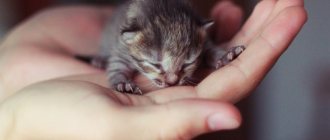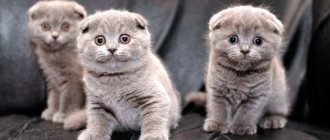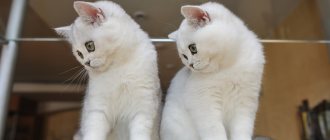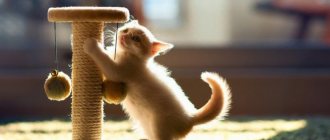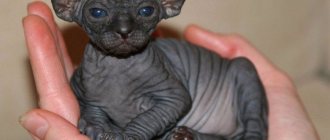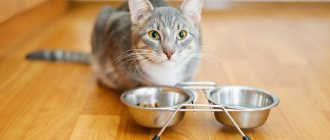A caring owner is always interested in whether his pet is developing correctly. In order to notice alarming trends in time, it is necessary to track the weight of the Scottish kitten by month.
It is important that the Scottish cat’s food is balanced and served in accordance with the regimen. Obesity not only spoils the pet's appearance, but is also dangerous to the animal's health in all aspects. Your Scottish Straight or Fold will live a long and happy life if treated well and with care.
Kitten at birth
Newborn “Scots” do not see, do not hear, and cannot regulate the temperature of their body. Babies have no undercoat - the hairs practically do not warm them. Kittens find it difficult to stand on their feet. Their bones are still very fragile, which is why it is important to treat the animal with care.
Scottish cats sleep all day, and during short periods of wakefulness they suck milk. Sleep is very important for them - at this time the nervous system continues to form. Babies cannot defecate - this process is stimulated by the mother cat, who cleans the “nest” of children’s excrement.
Kittens that have just been born already have a fairly developed sense of smell and touch - they quickly find their mother by smell and feel her nipples with their paws. Along with milk, the cat produces colostrum, which is rich in substances necessary for the formation of stable immunity in babies.
Human concern lies in two aspects: arranging a cozy corner for the cat family, balanced feeding of the mother. The owner changes the bedding and, if necessary, installs a heater or heating pad. Next to the “nest” he places bowls with water and food for the mother, her tray.
In the photo, video - a newborn Scottish:
This is interesting: Names for Scottish cats for girls
The first days of a kitten
In the first weeks, the young fluffy eats only mother's milk, and per day gains from 10 to 20 grams. So, if the weight after birth is known, then in the coming days you can estimate it with a certain accuracy without weighing.
At this time, babies are still blind, so they move little, staying close to the cat’s nipples. This circumstance contributes to the accumulation of mass, since the cub receives calories, but almost does not consume them. In addition, young creatures mainly sleep, so that by the time they are half-mooned they often weigh about 250 grams.
In order for the kittens to develop properly, the owner must be attentive to the optimality of the menu and the quality of the products that the mother cat eats. So you should purchase specially formulated food for her, and you should not set food restrictions for her.
By the half-month of life, babies have eyes. It is during this period that young fluffies begin to master movement on their own little paws. By this time, the baby’s weight can reach 420 grams. Just at this time, when kittens learn to walk, play and have fun, their appetite increases, so that their weight gain accelerates.
From the end of the third week, it is allowed to begin introducing the kittens to complementary foods a little at a time. But you should be aware that from the very beginning of complementary feeding this should be done using high-quality products.
The best choice would be specialized bagged food and canned food for kittens. It is not advisable to purchase cheap food, since it provokes the appearance of all kinds of diseases, for example, kidney stones.
Breed care
A fold-eared cat should be bathed no more than once every 3-4 months, or when it gets dirty. Use cat shampoo when bathing, after bathing, dry the cat with a towel and preferably dry it with a hairdryer, especially in winter, so that the animal does not catch a cold.
I bathe my cat once every three months, drying it with a hairdryer each time so that this wet creature does not fall onto a clean bed or get dust or other dirt on itself. Considering that my cat loves to lie in a large flower pot on the ground, drying with a hairdryer is a salvation from dirty paws and repeated bathing.
The fold-eared cat is the only one of all breeds that loves to be scratched against the grain. For combing, you can buy a comb with metal tips, but under no circumstances a slicker brush. A slicker can ruin the Scottish coat, and it will turn from plush to cotton wool, and the cat will lose its beautiful appearance. Long-haired cats need to be brushed once a day. Highland Folds do not like to swim, so once every 6 months will be enough.
Since the breed has floppy ears, cleaning should be done more often than regular cats. This is done twice a week using a cotton swab and ear drops for cats. The claws are trimmed as they grow back with special scissors; they remove the very tip of the claws.
When cutting, the main thing is not to touch the blood vessel in the claw.
cat litter
First you need to find a place for the cat litter box. Most often, owners choose a bathroom or toilet for these purposes; in some cases, it may be a corridor or landing on the stairs in a private house. For small kittens, the tray should be placed next to the house, and then, as they grow, you can move the tray to where it is convenient for you.
You also need to choose a litter tray for your pet. They come in three varieties:
- open with bars;
- open without grate, but with filler;
- Eurotoilet.
For a closed Euro-toilet you need a gel or silicate filler, their price is rather high, but the fillers block unpleasant odors, the tray itself looks nice, the filler does not scatter on the floor; The disadvantage of such a toilet is the large size of the tray, which may not fit in a small apartment.
A tray with filler is also very convenient: the tray itself is inexpensive, you can choose any filler for it according to your taste and wallet size, and it is convenient to change such a tray.
Ideal for cats - a large tray with filler
In my opinion, the most convenient filler is wood. You can find it in any store, it is inexpensive, and the filler lasts a long time. Absorbs liquid well, locking in odors. And cats find it more pleasant to walk on wood filler than on silicate balls or small pebbles.
For those people who are often at home and do not want to spend money on constantly buying fillers, we can recommend a simple tray with a mesh. It is convenient to rinse such a pot with water and wash it once a week with a chlorine-containing product to clean the tray and remove all odors.
This is exactly what happened with my cat. When I brought it home, I immediately put out a tray with wood filler. She showed him where his tray was and put him in it. The cat refused to go there for a day and endured it. Then I decided to remove the filler and leave the tray empty. I immediately went about my business and was pleased. So you should choose a toilet taking into account the cat’s characteristics and desires.
Feeding the fold breed
You need to feed the animal depending on its age:
- from 2 to 6 months - 5 times a day;
- from 6 to 8 months - three times a day;
- after eight months - twice a day.
The portion should be medium, you can find out its size by watching how much your pet eats. If the food is dry, then you can put more, the animal will still eat it later, but this option will not work with natural food, because it can turn sour throughout the day.
If you don’t want to give your cat dry food, you can feed it natural food. The diet should contain:
- sea fish;
- porridge;
- chicken;
- beef;
- turkey;
- cheese;
- cottage cheese;
- raw egg yolks;
- liver;
- vegetables.
It is not recommended to give to Scots:
- legumes;
- pork;
- potato;
- lamb;
- onion;
- milk;
- duck;
- sweet;
- salty and spicy foods;
- salty preserves;
- chicken or fish bones;
- sausage;
- smoked meats;
- river fish;
- egg whites.
Sometimes I give my cat sour milk or a little yogurt. Such products can be given to fold-eared cats, but in small quantities and infrequently. It’s better to leave cheese as a treat, otherwise the animal will not want to eat porridge or vegetables when there is plenty of tasty cheese.
From 1 to 3 months
During the second month of life, Scottish kittens continue to actively gain weight, which during this period ranges from 400 to 1500 grams. The owner needs to remember that the pet’s gender directly affects its body weight.
If figures of 400-600 grams are normal for a cat, for a cat of 2 months this is considered underweight.
The third month is characterized by a decrease in growth rate; during this period, the pet’s body weight is approximately 1-2.5 kilograms.
Weight of an adult cat, kg
Abyssinian cat
3.4-6.1
American Bobtail cat
4.0-7.2
American Curl cat
3.1-5.5
American shorthair cat
3.8-6.9
American Wirehair cat
3.6-6.5
Angora cat
3.2-5.8
Balinese cat
3.1-5.5
Bengal cat
4.0-7.2
Burma cats
3.6-6.5
Bombay cat
3.6-6.5
British shorthair cat
3.0-6.8
Burmesian cat
3.1-5.5
Burmila cats
3.4-6.1
Havana Brown cats
3.2-5.8
Himalayan cat
3.8-6.8
Devon Rex cats
2.8-5.1
Egyptian Mau cat
3.0-5.4
Cymric cats
3.5-6.3
Cornish Rex cat
2.7-4.8
Korat cats
3.2-5.8
Manx cats
3.5-6.3
Munchkin cats
3.2-5.8
Maine Coon cats
5.8-10.5
Nibelung cats
2.5-4.5
Norwegian Forest Cat
3.2-5.8
Orientally cats
3.0-5.3
Ocicat cat
4.4-7.9
Persian cat
3.8-6.8
Russian blue cat
2.5-4.5
Ragdoll cats
5.0-9.0
Selkirk Rex
3.6-6.6
Siamese cat
3.1-5.5
Siberian cat
4.0-7.2
Singapura cat
2.5-4.5
Snowshoe cats
3.4-6.1
Somali cats
3.25.8
Sphynx cat
3.4-6.1
Tiffany cats
4.0-7.2
Slim cat
3.5-6.3
Turkish Angora cat
3.3-5.9
Turkish Van cat
4.0-7.2
Chartreuse cats
3.8-6.9
Scottish fold cat
3.0-7.2
Exotic shorthair cat
3.8-6.8
Javanese cat
2.8-5.1
Japanese bobtail cat
2.8-5.1
Track your pet's weight and make sure he grows up healthy!
| In our cattery you can “buy a real British kitten.” We have many different colors, we will help you choose and answer all your questions! |
General information about the constitution of the Scottish kitten
Breeders of Scottish and British kittens often like to monitor the process of their pet's weight gain. They carefully monitor how the Scottish kitten grows and changes in weight during the first year of life. This is important for the breed quality of the animal and subsequently determines its status.
How much does a Scottish cat weigh? The Scots are not particularly large in size; they are somewhat more graceful than their British “relatives”. Regardless of whether your breed is lop-eared or straight-eared, the weight standards for both breeds are the same.
The Scottish cat is a harmoniously built breed. Representatives of this breed are quite stocky and muscular, with a medium length and body weight. An adult Scotsman usually weighs between 5 and 7 kg. Weight also depends on gender. There are cases when representatives of this breed gain significantly more than the norm. Therefore, it is quite difficult to answer the question of how much a Scots cat should weigh.
This is interesting: Names and nicknames for Scottish Fold cats
They have their own physiological characteristics
- Body. It is developed proportionally and has smooth lines.
- Paws. Most often of medium length with strong muscles. The structure of the feet is wide, thanks to which they can stand on them for a long time or sit like a person.
- Tail. Long and tapered at the end. No kinks or hooks.
- Head. Round with plush cheeks. The muzzle is neither flattened nor elongated. Even as adults they have a childish expression on their faces.
- Eyes. Big and round. Color varies depending on coat color.
- Ears. Small and triangular in shape. Pressed to the head if Scottish fold or straight if Scottish straight.
What to give?
After about 20 days of life, it is permissible for the kitten to introduce other complementary foods. Whether it's industrial feed or boiled beef/chicken, try to stick to one food line. If you don't have time to cook him a piece of meat every day or two, you will want to switch to dry food, but you need to do this gradually so that the kitten's body has time to adapt.
It is in the first months of life that a cat develops taste preferences, which he will adhere to. After a month, the kitten can be weaned from consuming milk alone. An adult cat does not live long on milk alone - it also needs other products.
In the very first days of complementary feeding, do not try to immediately give, in addition to meat (or food), several other products, such as: boiled egg yolk, black bread, broth. This is not an adult cat yet, and the kitten may have indigestion. A cat is not a person, he won’t be able to withstand such variety on the first day, he will simply vomit, act gradually.
If the goal is to diversify your Scottish kitten's diet, do not mix several foods in one meal. If a kitten develops a rash under its tail, then this is an allergy. By reacting in a timely manner, you will eliminate the product that caused it. In addition to the general rules of the diet, each animal has its own “unfavorite” product.
Raw yolk is given according to the same recommendations as milk and cream. As for industrial food, kittens that have just passed the age of one month need to be pre-soaked. After 1.5 months, that is, already at 2.5 months of age, they will learn to eat it in dry form, but do not forget about regularly adding fresh water to the “drinking bowl”.
Before the kittens are 3 months old, do not give them canned food or raw minced meat - the digestive processes do not immediately self-adjust for the absorption of such foods. After three months of age, a kitten’s diet approaches that of an adult cat. The mother cat should be protected: feeding kittens with natural cat milk too late can lead to exhaustion and early aging of her body. Everything is good in moderation, and experienced breeders are clearly aware of this.
How to choose the right food for a 2 month old pet
Breeders recommend choosing the same brand of food that was fed to the mother of the Scottish kitten for 2 months. However, given the fact that it is not always possible to buy expensive food, the type and brand can be selected individually, experimenting and giving your pet a small amount of food.
Main. so that it is balanced, ensures the presence of all necessary vitamins and microelements, since a growing body especially needs proper and balanced nutrition.
What are the dangers of gross dietary violations?
Overfeeding can lead to premature wear and tear of the gastrointestinal tract, in particular to problems with the liver and pancreas. The same applies to the use of cheap, low-quality feed, since a cat is not a rooster, it cannot digest, for example, low-quality grain.
An attempt to transfer exotic cats raised on food to bones and other products from the human table will only bring negative results. Such an adventure often ends in the death of these animals - they flatly refuse to eat.
Tips from breeders on how to feed kittens correctly are presented in the video below.
What to feed a kitten
If the new owner does not have time to prepare a full menu for the kitten from fresh and high-quality natural products, then the best choice is to accustom the “Scot” to premium dry and liquid food. This is a balanced and high-quality food that contains everything necessary for a representative of the breed. The breeder or veterinarian will help you decide on the brand and type of product - in many nurseries the animals are fed ready-made food.
Natural nutrition requires more time, money and effort. It cannot sometimes be replaced with ready-made food, so as not to cause persistent gastrointestinal problems in the kitten. If the baby was offered food from the breeder, the transition to natural nutrition goes very smoothly. The owner must monitor how the pet’s body reacts to a new dish.
The main rules for fans of natural feeding:
- Under no circumstances should you offer your pets raw fish due to the risk of helminths and infections. You should completely discard river water, and be sure to boil sea water, remove the bones and give it only in small portions - it can cause urolithiasis.
- Chicken and beef meat is cleaned of bones and cartilage, finely chopped or minced, boiled or doused with boiling water.
- Meat and fish are served with a “side dish” of porridge – buckwheat, oatmeal, rice. The “dish” is not salted or sweetened.
- The offal must be thoroughly washed and boiled.
- Fermented milk products - only with a small percentage of fat content, always fresh.
A Scot should have free access to filtered, boiled water at room temperature. A sufficient frequency of feedings is 4-5 times a day.
Recommendations for introducing complementary foods
For meat products, it is recommended to give preference to boiled or pre-frozen beef.
- Initially, you can put small pieces directly into the kitten’s mouth, and then gradually begin to accustom him to the plate. At 2.5 months, the pet should already be able to eat on its own.
- It is not recommended to give several different foods at once - this can lead to constipation. Also, if an animal develops an allergy, it will be difficult to determine what exactly. You can detect an allergic reaction by lifting the kitten's tail - there will be yellowish stains under it.
- The best source of calcium is cream with 10-15% fat content - it can be given 2 times a week in small portions from 4 weeks.
You should not feed your kitten canned food, purees, pasta or minced meat - these products have a negative effect on the digestive tract and can cause diarrhea.
At 1 year of age, you can stop monitoring your pet’s weight every month—after that, there won’t be much noticeable changes in your pet’s size or weight.
If the weight of a fold-eared cat is significantly lower than the specified minimum values, and tests do not reveal problems in the digestive tract, the doctor will help balance the diet and prescribe a vitamin complex.
If the Scottish Fold is visibly overweight, it is recommended to reduce the portions of the Scottish Fold's food and increase its physical activity - for this it is recommended to spend more time walking with the kitten. Obese pets increase the risk of diabetes mellitus and the development of problems in the cardiovascular system.
What to do if your weight is not normal
If underweight or overweight does not exceed 200 grams, then there is no reason to worry; most likely, the pet simply overate a little or did not move much. But if there is a large deviation from the norm, you need to contact a veterinarian, who will determine the cause and, if necessary, prescribe a course of treatment.
If your weight is below normal
If your Scottish Fold cat's weight at any stage of its growth is significantly below normal, you need to take your pet to a veterinarian. If the animal does not have problems with the gastrointestinal tract, the specialist will prescribe vitamins and give recommendations on changing the diet.
If your weight is higher than normal
Excess weight in a cat often causes the development of serious diseases, so the owner needs to monitor the diet and try not to overfeed the pet. If your pet is already overweight, you should review its diet and gradually reduce the portion size.
You will also have to take care of physical activity - you need to play with the cat more often to burn extra calories.
Scottish cat size
The answer to the question of what size a Scottish cat or cat depends not only on their weight, but also on their body length. There are miniature cats that do not grow much in length, and therefore their body weight should be less. In general, Scottish cats are medium in size. The normal length of a Scottish cat (excluding the tail) is around 55 cm, give or take.
The height of Scottish cats, that is, the height from the floor to the withers, in a standing position on four legs, is approximately 30 cm. This is important to consider when choosing a carrier, because... The cat should be able to stand up to its full height in it without bending down. The same applies to the house tray.
If your cat competes at shows, then not only its overall size becomes important, but also the length of its tail and limbs. Ideally, the tip of the tail should reach the shoulder blades when laid along the body. The paws should not be too thick and short, like those of the British: let us remind you that the skeleton of the Scots is lighter and more graceful.
The body of the Scottish cat is from medium size to large, rectangular in format - not a square, with rounded lines, proportionate at the level of the shoulders and croup. A body that is too stretched or massive is considered a fault. Wide chest. The head is round like a ball, with pronounced whiskers (mustaches) and chin.
MORE ON THE TOPIC
Animal health and size
In the first year of life, the owner of a Scottish kitten must carefully monitor how and how quickly he gains weight. Kittens weigh a little more than indicated in the table in the first weeks of life if there were few of them in the litter, and they receive a large amount of nutrients from their mother’s milk. The more kittens are born, the smaller their weight.
A kitten may be underweight if a nursing cat does not get enough calories from food. Another reason for lack of weight in the first week is the presence of congenital diseases and defects in the animal.
If a cat gains weight too quickly, this, like its lack, is considered a pathology. Too much weight is fraught with health problems. In obese animals, the risk of developing diabetes mellitus increases and there is an increased load on the heart muscle and vascular system.
If the causes of rapid weight gain are not identified and appropriate measures are not taken, the cat’s condition will only worsen with age.
If the weight is within the normal range, the “Scot” is active and mobile, this has the best effect on his formation and development. The musculoskeletal system is strengthened, internal organs work harmoniously.
Keeping body weight appropriate for age while maintaining proper nutrition is the best prevention of many diseases and guarantees a long life for the animal.
How to weigh
Determining the weight of a kitten at first glance seems somewhat complicated. However, everything is quite simple.
Methods:
- The first method is the most common, weighing on an electronic kitchen scale. Such scales show the result quite accurately, making weighing kittens from 0 months old very easy and simple.
- The second method also has the right to life. Here it is suggested to use commercial hand scales with a hook. To measure mass this way, you will need a bag or some other container to place the cat in. The container is pre-weighed separately. This method of measurement is far from the most accurate.
- The third method is more likely for adult animals whose weight is from 1 kg. You need floor scales on which you weigh yourself and then weigh yourself with your pet. The difference between the first and second weighing will be equal to the weight of the cat.
- The surest, but not the most convenient way, is to weigh the kitten in a veterinary clinic on special scales.
Issues of castration and sterilization of Scots
Many pet owners who do not want to breed them decide to castrate or sterilize. The problem of the pet's sex life disappears completely. Scottish Folds can be neutered after reaching 1 year of age.
The probability of complications after castration is 0.05%. The operation lasts about 15 minutes, is considered practically safe, but is performed under anesthesia. After castration, the animal becomes more docile and affectionate and does not mark its territory.
To prevent unwanted pregnancies, a Scottish Fold cat is sterilized at 6–7 months. You should not wait for the first pregnancy to occur, but if this happens, you can also sterilize the pregnant pet.
How to maintain body weight
To ensure the kitten’s full development and weight gain according to the established norms, it is necessary to take care of proper complementary feeding. It is recommended to introduce it from about 3 weeks.
From this point on, the cat's breast milk cannot fully provide a sufficient amount of calories, so the active growth of the animal may stop.
To maintain your pet's weight, new foods must be introduced correctly, following these guidelines:
- As the first “adult” food, a kitten can be given lean meat. Preference should be given to beef. The meat must be boiled or pre-frozen. First, you can put it in small pieces directly into the animal’s mouth. Gradually, the kitten needs to be taught to eat from a bowl. By 10 weeks the cat should be able to eat on his own.
- It is recommended to introduce new products one at a time. You cannot give 2 new ingredients at once on the same day. The digestive system will have a hard time coping with this. In addition, if an allergic reaction occurs, it will be difficult to understand which product triggered it.
- For normal growth of the kitten, calcium must be administered. Its source can be 10% fat cream. They can be given from the age of 1 month.
- During the period of introducing complementary foods, you need to carefully monitor the condition of your pet. Experts recommend periodically looking under the kitten’s tail. If yellow or brown streaks appear on the fur, this indicates the presence of an allergic reaction.
- You should not give your kitten canned food, minced meat or puree. They negatively affect the state of the digestive system. Many people believe that pureed foods are better accepted by the body. But such food can cause prolonged diarrhea. It is better to give harder food so that teeth develop faster.
A sudden change in diet can affect your pet's growth and development. Therefore, the owner of the kitten must choose in advance what he will feed it: natural products or commercial food.
Industrial products need to be selected according to the age of the kitten. It is important to purchase only high-quality feed that contains all the necessary vitamins and mineral elements that ensure the active growth and development of the animal.
To maintain body weight, muscle development, and growth, the kitten must be provided with sufficient physical activity. Regular games with your pet will help strengthen the musculoskeletal system and the proper development of internal organs.
If the cat’s weight begins to change up or down, this is a reason to immediately contact a veterinarian.
Characteristics of age
Kittens at 1 month are still just mastering the world around them. At this time, they begin to actively crawl around their mother and even into neighboring rooms. The mother is not very happy with this, because... The kittens may disappear from sight, so she tries to collect them in a pile. A particularly inquisitive cat may bite its whiskers, because... With the help of their whiskers, cats navigate in space, and, having lost them, they become less self-confident.
Little kittens do not yet know how to go to the litter box, doing it every other time or not doing it at all: many choose the wrong places, contrary to the example of the mother and the complaints of the breeders. But a little more - and these guys will learn everything as required by cat etiquette.
Article continues after advertisement
At the age of 1 month, kittens actively play with each other and with their mother, trying various predatory tricks. But the mother stops their attempts to play with the claws: in this way she develops in the children a manner of playing softly, which future owners will really like. Kittens have not yet mastered this skill at 1 month, so wait at least until 2 months until the mother reinforces it.
Development table
The correct development of the Scottish Fold can be judged by the baby's weight gain. This is demonstrated by the weight table by month, based on standard indicators for the breed.
| Age (months) | Male weight (kg) | Female weight (kg) |
| 1 | 0,45-0,7 | 0,3-0,6 |
| 2 | 0,8-1,6 | 0,4-0,75 |
| 3 | 1,3-2,4 | 1,2-1,6 |
| 4 | 2-3,7 | 1,7-2,3 |
| 5 | 2,4-4,2 | 2,2-3,1 |
| 6 | 3-5,5 | 2,3-3,6 |
| 8 | 3,5-6 | 2,9-4,3 |
| 10 | 4,2-7,1 | 3,1-4,6 |
| 12 | 4,6-7,3 | 3,2-5,3 |
| 24 | 5,5-8 | 3,5-5,6 |
The physical development of a Scottish cat is completed by the 2nd year of life. The animal becomes massive and imposing. Kitties are more graceful, cats are more muscular.
Nurseries in Moscow, St. Petersburg and other large cities
nursery
| Breed type | felinological system | Color | Vet. vaccination passport deworming | Metric with pedigree | note | |||||
| Moscow | ||||||||||
| LOVELY LAPATAN | Scottish Straight, Scottish Fold, Highland Straight and Highland Fold. | WCF | on golden or color point | available | available | Tray trained | ||||
| SHEN-ALIN | Scottish Straight, Scottish Fold, Highland Straight and Highland Fold | WCF | golden, silver chinchilla shaded, ticked. | pedigree castration/sterilization of the animal | mixed food type | |||||
| MURKINO | Scottish Straight, Scottish Fold, Highland Straight and Highland Fold | WCF | gold or silver | available | receive a package of documents | |||||
| Saint Petersburg | ||||||||||
| Hathor Club. | Scottish fold | chocolate silver | available | receive a package of documents | ||||||
| BOLEMUR | Scottish Straight, Scottish Fold, Highland Straight and Highland Fold | WCF | gold or color point | available | package of documents | to professional food, tray, scratching posts | ||||
| Kazan | ||||||||||
| MELODY SOUL | Scottish Straight, Scottish Fold, Highland Straight and Highland Fold | gold, silver, colorful. | Veterinary care | package of documents | super premium, holistic | |||||
| Ulyanovsk | ||||||||||
| Ulyanovsk cats | Scottish Straight, Scottish Fold, Highland Straight and Highland Fold. | ticked, gold, color-point | vaccinated | a pedigree is issued, but only after castration. | accustomed to all cat wisdom | |||||
How to feed little Scots
As mentioned above, the first feeding of Scots begins at three weeks of age. In order for a Scot to be healthy and gain the required weight, he needs to be well fed. The Scot will consume breast milk for up to 2-3 months, after which he must finally switch to a diet independent of the mother.
How and what to feed your Scottish baby:
- Starting from 3 weeks, you can give finely chopped (scraped) frozen or boiled beef. It must be placed in the baby’s mouth, it is better to start with once a day and gradually increase to three times. Around the end of the 4th week, they will be able to cope on their own without your help.
- You cannot give several new products at once (in one day). This will help track the moment if the kids develop allergies.
- Canned food, purees and minced meat should also be excluded. No matter how strange it may sound, in this form the products are not accepted by the stomach, so the nutrients will not reach their target. Moreover, the baby may have loose stools.
- You can start giving cream with 10% fat as early as a month. In order for the baby to drink them himself, you will have to help him. Dip your finger in the cream and touch it to your pet's nose. If he likes the taste, you can slightly push his face towards the saucer.
- Carry out regular inspection of your pets, namely, look under their tail. If there are yellow or brown stains on the fur, this indicates that the kitten is having an allergic reaction to something.
- Raw yolk is also a suitable complementary food. It should be given according to the principle of cream.
- If you want to feed your babies with specialized industrially produced food in the future, then it is best to start giving them from the age of one month. Naturally, in this case you do not give them natural food. Initially, the food will have to be soaked in warm water and lubricated with it on the baby's palate . So they will try it. After that, it is necessary to reduce the moisture content of the feed. Gradually, the kids will get used to it and will consume it in dry form.
- By 10 weeks, all babies should be able to eat and drink on their own. You should start taking care of your mother cat.
The second stage is independence and growing up
| Age | Image | Peculiarities | Recommendations |
| Sixth week | The final transition from mother's milk to foreign food | Feed the kitten 6 times a day, 40 grams of food at each meal. Observe the animal's stool; if there are any problems, contact a veterinarian after 3 days. | |
| Seventh week | Weight – 550-900 g. Males stand out among females in size | The kitten should not drink its mother's milk. Balance of dry and liquid food | |
| Eighth week | Weight – 750 – 1200 g. All milk teeth. Eats solid food | Separate from mother. Get examined by a veterinarian. Monitor the condition of your ears and eyes. Comb | |
| Ninth week | Forming a type of relationship with the owners | Get vaccinated | |
| Tenth week | Weight – 850-1400 g. Independence. Sensitivity to learning | Do not be aggressive in training | |
| Eleventh week | Research stage: exploring the corners of the apartment | Prevent the kitten from colliding with dangerous objects: close windows, remove small parts, toxic substances | |
| Twelfth week | Weight – 900-1600 g. Change of eyes Pet’s response to its name, to the call for food | Organize repeated prophylaxis against worms. Stop kitten aggression | |
| Thirteenth – fifteenth weeks | Weight – 1.5 kg. Molars appear | Feed 5 times a day. Trim nails regularly | |
| Sixteenth week | Weight – 1.8 kg | Get vaccinated | |
| Five months | Weight – 2 kg | Feed 4 times a day. Get a rabies vaccination | |
| Six months | Strong molars. Dimensions of an adult animal. Puberty | Organize worm prevention. Feed 3 times a day. Sterilize if there is no goal to breed offspring | |
| Seven months | Seasonal molt | Brushing your pet | |
| Eight – nine months | The cat is almost an adult | Sterilize if not done before. Consult your doctor about vaccination | |
| Ten – eleven months | Adult phase of life | Include food for adult cats in the diet |
Cat vaccination periods
Feeding in the first year of life
Like kittens of other breeds, Scottish kittens consume only mother's milk up to 3 weeks. If an accident occurs, for example, a Scottish cat died during childbirth, from a malignant disease or due to accidental poisoning, or ran out onto the roadway, refused to feed the kittens, or other accidents, then orphaned kittens will benefit from milk formulas that are extremely close in composition to cat milk.
Good products are produced, for example, by Royal Canin, which specializes mainly in dog and cat food. Manufacturers of such products ensure that the fat content does not exceed 10%, and the vitamin content of the compositions is sufficient for the growing body of dogs and cats.
If there is no specialized store or veterinary hospital with a mini-store nearby where you can choose food for any kittens and puppies, act independently. To reduce the fat content, village (farm) milk is diluted in half with boiled water or cleared of cream and given to a newborn kitten to taste. They begin to feed it off, gradually reducing the number of meals per day from day to day, but increasing the volume of each complementary food.
You can take the nutrition of any average outbred kitten as a basis - all kittens consume approximately the same amount of milk. A specific breed - the same Scottish cats - requires its own amount of food in the first days and weeks of life, but you can save the life of your ward and let him grow up, adhering to the norm of “street” kittens.
The main thing is not to overfeed, not to underfeed, and not to forget about feeding regularly, otherwise the kitten will be late in gaining weight and will not develop properly, which will lead to illness and premature death later.
Pet in the house
When taking on the responsibility of keeping a furry pet, you must be extremely careful. At the very beginning of its stay in a new place, the kitten may be a little scared. This is due to the fact that the new environment will be unusual for him. How quickly the kitten gets used to its new owner and environment depends on the first hours of its stay. In order for this process to go as smoothly as possible, it is necessary to take care of preparing the area for the new home inhabitant. You need to determine the place where the kitten will feed, where there will be a rest area with personal toys and, of course, a place where the tray will be placed.
Do not rush the kitten or force it to take certain actions. You just need to wait and be patient. Often, when pets come to a new place, they determine convenient zones for themselves, but the main thing for the owners is that they have access.
To facilitate the process of adaptation to a new place, you need to not interfere with the kitten’s settling in where he liked it. Since Scottish Fold kittens are very sociable, you can interest him in a toy or game, thus helping him get comfortable. In addition, during the game he will begin to get used to the new owner, and the feeling of fear will pass by itself. Experts do not recommend leaving your pet alone in the room; it is better to take it with you at first.
Features of kitten growth
Representatives of both the Scottish and British breeds are distinguished by their large and muscular physique. Adult straight-eared and lop-eared individuals weigh between 5–7 kg.
Weight gain is especially noticeable in the first year of an animal’s life. Therefore, at this time the kitten should receive the optimal amount of nutrients and supplements (minerals, vitamins). A balanced diet will allow the kitten not only to develop properly, but also to maintain health at a high level.
Knowing how much a Scottish cat weighs at a given age can help you avoid a lot of problems. Therefore, it is important to track this indicator during the first year of your furry pet's life.
When and how to bathe a 2 month old Scottish Fold kitten?
A small pet begins to be bathed only from the age of two months, and then only when it is heavily soiled or when fleas appear. Wash in warm water about 36 degrees with special shampoo. It is better to pour the water in advance, because the Scotsman is very frightened by its noise. It is advisable to put a rubber toy in the bath and water the animal from a ladle. The soap solution must be washed off thoroughly so that when licked, the product does not cause irritation.
Before bathing, oil drops are instilled into the pet's eyes to prevent irritation of the mucous membrane. Cotton swabs are inserted into the ears. After the water procedure, the baby’s fur is dried with a towel and a hairdryer at a distance of half a meter. Make sure your kitten doesn't catch a cold. The shampoo that the owners use is not suitable for the kitten; it will cause severe allergies.

